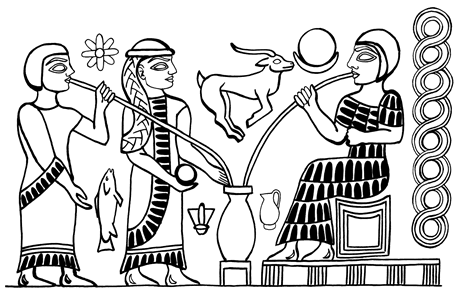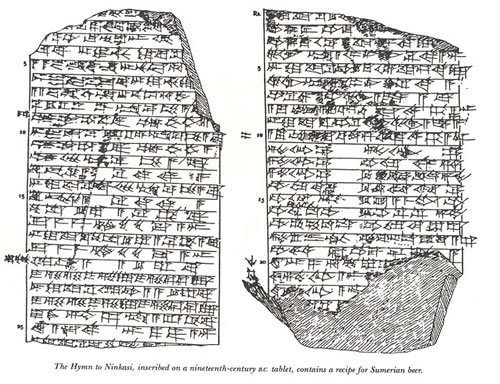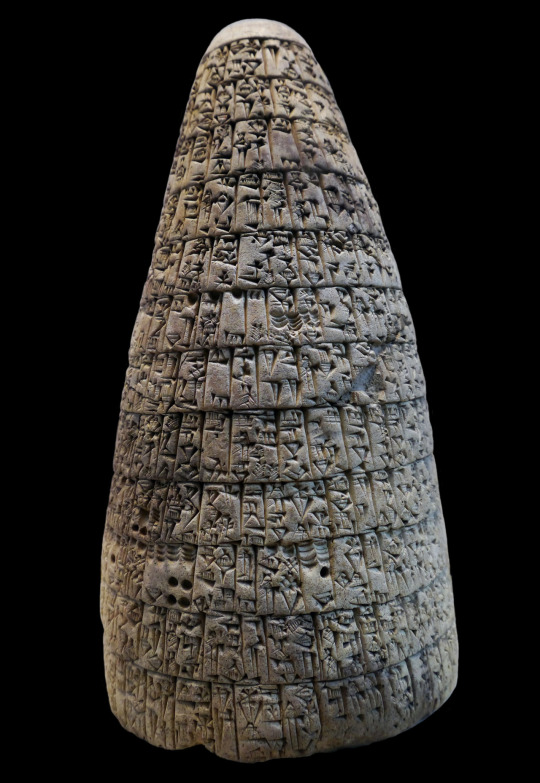#sumerian history
Text
Inanna is another of the ancient archetypes, the Goddess of Sex and War:
A related concept, too, is that of the fertility Goddess. To denote the obvious, pre-Christian polytheism wasn't scared of its own genitals in any of the ways that Christianity and Islam can be at times. Fertility Goddesses were very earthy and sexualized, and present more than a bit of a dilemma for modern feminism. They are literal entities of sex and sexuality, which modern feminism can, at times, associate with being rape in and of itself, because all sex is rape. This is a particular view of second and third wave feminism that has more than a few challenges to it, but these are also the waves that want the Goddess archetype to fit into something it does not always.
Inanna was an archetype that might or might not have influenced Aphrodite depending on how much one is willing to admit to the idea that a Sex Goddess can only be seen in so many ways. One can see in these parallels, too, the reality that these people did not live in a vacuum and that concepts of the divine would have rubbed off (haw haw) on one another.
But as with Aphrodite, and Freyja much moreso, Inanna in particular retains an association with war. Not the erudite planning war of Athena, either. The bloody raw visceral type identified with Ares. The Ancient World was much franker than the modern world on some things, and the ideas of the Goddess in actual tangible form does not exactly reflect a feminine ethos of women shaped by women, in its preserved form so much as the sacred feminine shaped by men and written by men.
#lightdancer comments on history#women's history month#sumerian history#sumeria and women's history#the goddess in theory and in reality
6 notes
·
View notes
Text
I thought the slavery season of Empire would be a huge downer but episode 1 is actually about how the pyramids, stonehenge, and Sumerian ziggurats (and canals and so on) weren't built by slaves, but essentially ran on the same system as getting your mates over to move furniture in exchange for pizza and beer.
Like we all know about the Drunkards of Menkaure, but the worker's town near the pyramids has animal remains clearly showing they ate lots of meat, far more than an Egyptian farmer would normally eat. And nearby Stonehenge they've found a similar settlement with lots of cooked pig bones. And Sumerian texts describe corvee labour as being a big party, like a barn raising or other working bee, where even the king was expected to pitch in and do his bit.
(Though of course part of the description was "The whip did not strike!" which implies that at other times, people were getting whipped.)
#Empire podcast#anita anand#will dalrymple#ancient history#sumerian history#ancient egypt#egyptian history#david wengrow
5 notes
·
View notes
Text
Something that I get chills about is the fact that the oldest story told made by the oldest civilization opens with "In those days, in those distant days, in those ancient nights."
This confirms that there is a civilization older than the Sumerians that we have yet to find
Some people get existential dread from this
Me? I think it's fucking awesome it shows just how much of this world we have yet to discover and that is just fascinating
#the epic of gilgamesh#gilgamesh#enkidu#sumerian#ancient history#world history#history#ancient sumeria#sumeria#ancient times#ancient civilizations#bronze age#ancient literature#ancient legends#mesopotamia#ancient mesopotamia#akkadian#mythology#sumerian mythology#mesopotamian mythology#mesopotamian#ancient mystery#ancient myths#ancient mythology#ancient myth#ancient legend#ancient myths and legends#ancient past#epic of gilgamesh#ancient epic
2K notes
·
View notes
Text

NIRAH
Nirah brings a message from the watchful sky. He arrives at the gates of Nippur with torment in his heart. “I can see the future,” he tells the very first woman. “Your kind will destroy everything.”
The men go to war as civilisation falls apart—the very first lesson in history. The first time there was ever a mistake.
Is it just a coincidence that the messenger was a snake?
#literature#my writing#poetry#short poem#adventure#sumerian#artists on tumblr#original art#digital art#my art#art#artwork#art history#modern art
181 notes
·
View notes
Photo

The Sumerians were the people of southern Mesopotamia whose civilization flourished between c. 4100-1750 BCE. Their name comes from the region which is frequently – and incorrectly – referred to as a “country”. Sumer was never a cohesive political entity, however, but a region of city-states each with its own king. Sumer was the southern counterpart to the northern region of Akkad whose people gave Sumer its name, meaning “land of the civilized kings”. The Sumerians themselves referred to their region simply as “the land” or “the land of the black-headed people”. The Sumerians were responsible for many of the most important innovations, inventions, and concepts taken for granted in the present day. They essentially “invented” time by dividing day and night into 12-hour periods, hours into 60 minutes, and minutes into 60 seconds. Their other innovations and inventions include the first schools, the earliest version of the tale of the Great Flood and other biblical narratives, the oldest heroic epic, governmental bureaucracy, monumental architecture, and irrigation techniques. After the rise of the Amorites in Mesopotamia, and the invasion of the Elamites, Sumer ceased to exist and was only known through references in the works of ancient writers, including the scribes who wrote the biblical Book of Genesis. Sumer remained unknown until the mid-19th century CE when excavations in Mesopotamia unearthed their civilization and brought their many contributions to light.
127 notes
·
View notes
Text

Detail of a temple wall from the Sumerian city of Uruk in Mesopotamia. The temple that dates back to the late 15th century BCE was dedicated to worshiping the Sumerian goddess Inanna, known as the Lady of Heaven. The Pergamon Museum, Berlin, GERMANY.
Photo by Babylon Chronicle
689 notes
·
View notes
Text

rosier, after bacchus by caravaggio c. 1596
#my beloved …. my favorite …#it always makes my art history degree happy to do things like this#he’s wearing ancient sumerian jewelry! a woman in ur wore things just like this!! so long ago!#my art#rosier#angels before man#rosier abm#abm#asmodeus#asmodeus abm#tw blood#asmodeus is barely there. sorry
127 notes
·
View notes
Text



The Hymn of Ninkasi
The Ancient Sumerians loved their beer. In fact they loved their beer so much that thousands of years later ancient recipes and artwork depicting beer making and beer drinking survive to this day. Many of these recipes are being recreated and brewed thousands of years later by crafted breweries today. They drank it for ceremonial and religious reasons, they drank it for nutritional reasons, and they drank it for the same reasons we drink it today. You know ... to get pissed.
The Sumerians were so serious about their beer that they had their own deity devoted to the beverage named Ninkasi. Ninkasi was the goddess of beer and alcohol, who brewed the beverage daily to to “satisfy the desire” and “sate the heart.” One of the earliest known devotions to Ninkasi was a hymn written on clay tablets dating to 1800 BC. Called “The Hymn to Ninkasi” it was more than just a devotional script or prayer, it was a recipe and procedure for brewing, written as a poem so that it would be easy to remember in an age when most people were illiterate. The beer that was produced was a very sweet beverage with around 3.5% alcohol by volume, created by brewing with malt and a twice baked honey bread (bappir) that had the taste and consistency of granola. It would have been very sweet compared to modern beer as the Sumerians lacked hops which gives the bitter flavors of beers today. Traditionally the beer was stored in clay pots and sipped using long drinking straws to filter out left over particulates.
The Hymn of Ninkasi
Borne of the flowing water,
Tenderly cared for by the Ninhursag,
Borne of the flowing water,
Tenderly cared for by the Ninhursag,
Having founded your town by the sacred lake,
She finished its great walls for you,
Ninkasi, having founded your town by the sacred lake,
She finished it’s walls for you,
Your father is Enki, Lord Nidimmud,
Your mother is Ninti, the queen of the sacred lake.
Ninkasi, your father is Enki, Lord Nidimmud,
Your mother is Ninti, the queen of the sacred lake.
You are the one who handles the dough [and] with a big shovel,
Mixing in a pit, the bappir with sweet aromatics,
Ninkasi, you are the one who handles the dough [and] with a big shovel,
Mixing in a pit, the bappir with [date] - honey,
You are the one who bakes the bappir in the big oven,
Puts in order the piles of hulled grains,
Ninkasi, you are the one who bakes the bappir in the big oven,
Puts in order the piles of hulled grains,
You are the one who waters the malt set on the ground,
The noble dogs keep away even the potentates,
Ninkasi, you are the one who waters the malt set on the ground,
The noble dogs keep away even the potentates,
You are the one who soaks the malt in a jar,
The waves rise, the waves fall.
Ninkasi, you are the one who soaks the malt in a jar,
The waves rise, the waves fall.
You are the one who spreads the cooked mash on large reed mats,
Coolness overcomes,
Ninkasi, you are the one who spreads the cooked mash on large reed mats,
Coolness overcomes,
You are the one who holds with both hands the great sweet wort,
Brewing [it] with honey [and] wine
(You the sweet wort to the vessel)
Ninkasi, (…)(You the sweet wort to the vessel)
The filtering vat, which makes a pleasant sound,
You place appropriately on a large collector vat.
Ninkasi, the filtering vat, which makes a pleasant sound,
You place appropriately on a large collector vat.
When you pour out the filtered beer of the collector vat,
It is [like] the onrush of Tigris and Euphrates.
Ninkasi, you are the one who pours out the filtered beer of the collector vat, It is [like] the onrush of Tigris and Euphrates.
316 notes
·
View notes
Text

brat sumer
#brat#brat summer#sumerian#sumer#ancient history#ancient languages#history#history memes#language#langblr#language blog#languageblr#language meme#language memes#cuneiform#charli xcx
59 notes
·
View notes
Photo

Cone of Urukagina, king of Lagash, circa 2350 BC,
Girsu, Mesopotamia,
Detailing his reforms againt abuse of "old days".
Height: 27 cm (10.6 in); diameter: 15 cm (5.9 in).
Collections of the Louvre (Department of Near Eastern Antiquities).
#art#design#sculpture#writing#words#king of lagash#girsu#mesopotamia#le louvre#cone#urukagina#styl#history#ideographic#cuneiform#sumerian
865 notes
·
View notes
Text
Prehistory is the beginning of humanity, history has multiple beginnings. Starting with Sumeria, here:
Today in Women's History Month, women of Sumeria, Egypt, Assyria, and the Levant/Israel/Canaan. This will include both real life women and various mythological figures, because the archetypes of femininity, due to the degree to which gender is always a deliberately created ideological construct shape reality as much as....reality.
Beginning with Sumeria because the people of the Black Hair were first. And in this case with Kubaba, the Queen of one of Sumer's city-states who rose as a product of one of the first occupations women had, specifically a bartender. Beer and alcohol were associated with one of the many deities of the Sumerian world, and as such to be a tavern keeper and brew and mix drinks was literally a sacred rite. In Sumeria the line between the priest and the king or the queen was then, and Kubaba crossed that line.
One of the points this raises, too, is that no matter how powerful and 'classical' Patriarchy gets, women always find ways to take and hold power. So then there's the question of how much one assigns to this. Does this reality indicate that patriarchy is not entirely as absolute a force as it seems, or does it indicate that women in power cease to truly be women when it's convenient for them to be, if they don't fit preconceived criteria?
Or alternately is it that women's history, like all histories, is a history of elites and nobles until very recently, and that these elite, noble women tend to be the ones who get the lionness's share of attention and books? All the same the reality is that as soon as there were states and rulers, there were queens who took power in their own right to rule them.
6 notes
·
View notes
Text

#mesopotamia#sumerian#Sumer#history#mythology#Bronze Age#Ishtar#Gilgamesh#the epic of gilgamesh#epic of gilgamesh#John waters#divine#divine drag queen#pink flamingos
95 notes
·
View notes
Text
Time Travel Question : Assorted Performances I
These Questions are the result of suggestions from the previous iteration.
This category may include suggestions made too late to fall into the correct grouping.
Please add new suggestions below if you have them for future consideration.
#Time Travel#Drama History#Ancient Athens#Ancient Greece#Hegelochus#Euripides#Orestes#Aristophanes#Dionysian Festival#Aeschylus#Lost Literature#Ancient Greek Literature#Oresteia#Homer#Classical Athens#Music History#Ancient World#Enheduanna#Ur#Sumerians#Ancient Egypt#Sappho#Epidaurus
109 notes
·
View notes
Text

Tinkering around in blender and gimp rn
#my wips#sims 4#s4mm#sims 4 history#mesopotamia#mesopotamian#assyrian#assyria#sumer#sumerian#queen puabi#bablyonian#bablyon#wip hair#wip outfits
171 notes
·
View notes
Text

Being Transgender is not a modern or a Western idea, as it can be found throughout history in many different cultures!
🏳️🌈🏳️⚧️🏳️🌈
#history#gala#transgender#pilipili#sumerian#womens history#mesopotamia#inanna#lgbt#eme-sal#trans women#ancient history#lgbtq#divine feminine#gender#goddess#mythology#trans pride#ancient culture#lgbt history#ancient#priestesses#sumerian mythology#nickys facts
19 notes
·
View notes
Text

Yup...
God, China, why
Anyways , to not go insane , yet, I've chosen these five ancient civilizations to start!

For now the only one is Sumer , being born in 5500 BCE

"Goats were apparently the first species to be domesticated as livestock about 8000 b. c. in the area of Mesopotamia, today's Middle East. This region of domestication was also the cradle of one of the first civilisations, the Sumerians, and goats had a strong impact on all phases of their life." X
35 notes
·
View notes